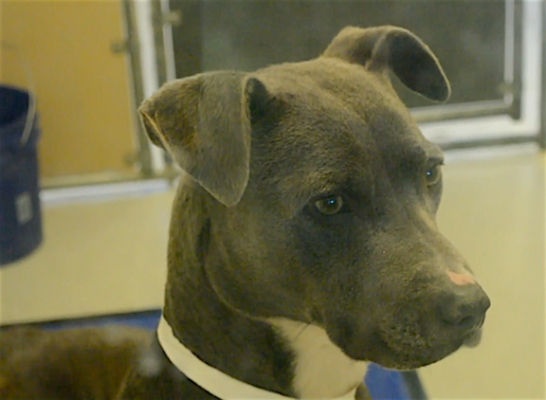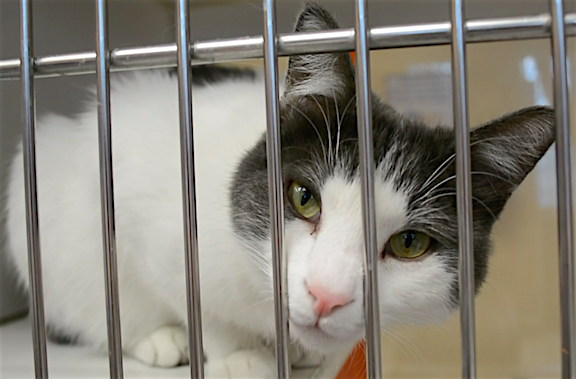Dogs and cats are locked in small enclosures, expressing confusion and fright.
They look out a thick layer of glass, presumably hoping a passerby will take them to a new home.
For most, their fate was to go into a room and receive an injection and everything goes black.
That was the prognosis for some 75 percent of the animals impounded at El Paso Animal Services in 2012. More than 25,000 of the 33,000 animals impounded that year were were euthanized, according to shelter documents.
Five years later, that statistic has vastly improved. Of the nearly 25,000 dogs and cats impounded over the past year, 8,628 were euthanized, which equates to a live release rate of 66 percent, which includes adoptions, returns to owners, foster care placements, and relocations to other animal welfare organizations.
“This year has been very good,” says Mike Ross, a shelter volunteer of three years. “The population is down considerably.”
El Paso Animal Services is the only city-run shelter. Its mission, according to a report, is “to compassionately provide for the health, safety, and welfare of El Paso companion animals in our care, and to advocate for animals in the community through education, community partnerships, and responsible pet ownership.”

Pit Bull impounded at El Paso Animal Services gazes out the window of his kennel.
Open seven days a week, the shelter’s services include pet adoptions, stray animal pickups, city permits and licenses, public education, affordable vaccinations and micro chipping, lower-cost spay and neutering, as well as other various animal-related concerns pertaining to public health.
While the mission of Animal Services has remained similar over the years, its practices haven’t always been carried out in such positive ways. Inadequately-sized kennels, improper animal disposal practices, and lack of public awareness were just some of the of the areas that needed improvement.
After citizens and animal advocates made frequent complaints about the dismal state of Animal Services, El Paso City Council created a team—composed of officials from the city’s health, environment, and animal services departments—in 2015 to help facilitate the changes the shelter so desperately needed.
In order to qualify as “no-kill”, a shelter must reach at least a 90 percent live-release rate, Michele Anderson, public affairs specialist for the city’s Department of Animal Services.
An Animal Services task force identified several key measures the shelter has implemented to achieve a lower kill rate after visiting several so-called “success story” shelters across the region that have achieved this status.
- Trap-Neuter-Release Program for stray cats
- High-volume, low-cost sterilizations
- Collaboration with local rescue groups
- More foster care opportunities
- Easy, affordable adoptions
- Resources provided to owners to help them keep their pets
- Medical and behavioral rehabilitation
- Increased community awareness and involvement
- Successfully returning stray animals back to their owners
- Effective, compassionate leadership
In January 2016, recognizing the community’s desire for change, City Council approved the multi-million-dollar increase in the shelter’s budget necessary to implement these plans.
El Pasoans “have expressed in great numbers and with great passion that they no longer have an appetite for killing our animals,” the team said in a January 2016 report.
“People do want to save more animals. This community wants to be 90 percent,” Anderson said. “Without (City Council) approving that and approving a budget and everything like that, we definitely would not have been able to come as far as we have.”

Cat housed at El Paso Animal Services peers through the metal bars of her cage.
By 2020, shelter officials hope to reach the high live-release threshold of 90 percent, according to the Five Year Plan described in the task force report.
Currently in (fiscal) Year Two, which spans from September 2016 to September 2017, the shelter’s goal is to hit a 60 percent average live-release rate. It also plans to raise public awareness by increasing its advertising efforts, continuing to hold more off-site adoptions, and increase the number of altered animals by waiving fees for owners who agree to spay or neuter their pets.
“We’re not anywhere close to 90 percent yet, but…we’re on that trend to be there and we’re doing pretty well,” Anderson said. “It doesn’t happen overnight, but we’ve made great strides.”
The decrease in euthanasia rates is among several other notable changes at the shelter. Of the increased budget, $1,084 million was designated solely for facility improvements, including front office renovations, mural and mosaic artworks, and two new play areas equipped with toys, artificial grass, and kiddie pools.
The shelter also has plans to expand its personnel by hiring a community outreach coordinator later this year and a second animal enrichment specialist in 2018.
“Having an education program in place will definitely help,” Anderson said, “and [animal enrichment] really makes a huge difference…the animals don’t look so sad, they actually look happy and have a good energy.”
In its pursuit of reaching no-kill status, Animal Services stresses the importance of working with the community in order to save its animals.
Pet owners “have to be loyal until the end,” said Carlos Claudio, a volunteer. “People should be more responsible of their pets.”
Responsible pet ownership involves keeping animals healthy, happy, and safe, the shelter staff emphasizes. “Spay, neuter, microchip – those are probably the three most important things that can be done,” Ross said. “It helps a lot if there aren’t as many animals coming in every day in the first place.”
Anderson agreed: “We’ve been on a downward trend of just general intake,” she says, with the shelter having received 2,000 fewer animals each year. “The [pet] overpopulation in El Paso has really decreased.”
Until its intake number reaches zero, Animal Services will continue its efforts until every animal in El Paso has a loving home. “Our goal is 100 percent,” Claudio said. And, with a little luck and the cooperation of the community, the shelter might one day reach that.
Anyone interested in adopting or caring for a pet, or in ways to limit pet over-population is encouraged to visit the Animal Services’ newly-revamped website at or stop by the shelter located at 5001 Fred Wilson.

